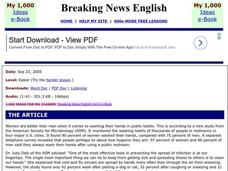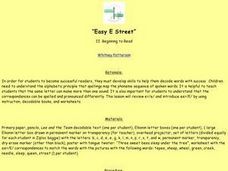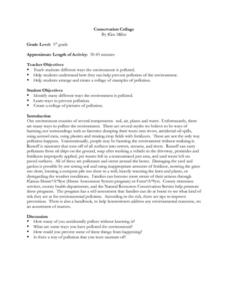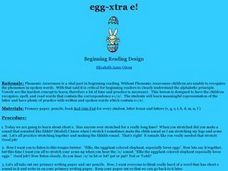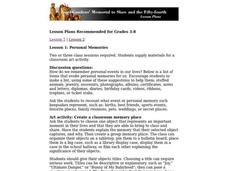Curated OER
Breaking News English: Women Wash Hands More Often Than Men
In this English learning exercise, learners read "Women Wash Hands More Often Than Men," and then respond to 47 fill in the blank, 7 short answer, 20 matching, and 8 true or false questions about the selection.
Curated OER
Zoom Zoom Zoom
Student increase their reading fluency through the use of various strategies. After reviewing good reader strategies, students complete an initial read of a novel text. Working with a partner, they read complete a timed assessment of...
Curated OER
Creaky Door E
Students recognize the short vowel "E" in written and spoken language. Through matching activities, they discriminate the short vowel /e/ from other phonemes. Students associate the phoneme with its letter representation and fill in the...
Curated OER
Removing the 'Junky' Words
Students explore was to comprehend a story through summarization. They are introduced to a lesson by explaining that when we read there are a lot of extra, unnecessary, junk words. Students explore ways not pay to attention to the...
Curated OER
"Easy E Street"
Learners investigate how the same letter can make more than one sound. It is also important for students to understand that the correspondences can be spelled and pronounced differently. This instructional activity will review e=/e/ and...
Curated OER
Ta-Ta- Timer
Students identify a letter of the alphabet. They recognize this letter in print and in spoken language. The letter and phoneme chosen is the letter t and /t/. They write the letter in both lower and upper case. They read 'One Tiny...
Curated OER
D says DUH! Duh?
Pupils identify the letter D, both upper and lower case and recognize and identify the letter d in various words and illustrations. They identify how the mouth moves with the letter D through various word pronunciations. Finally,...
Curated OER
Tick Tock /t/
Students review letter recognition for the letter /t/ and the sound of the letter /t/. They write an upper- and lower-case /t/ and recognize the sound of t as well as the letter when combined with other letters in the form of a word.
Curated OER
Olly at the Doctor
Students recognize the short vowel "O" in written and spoken language. Through matching activities, they discriminate the short vowel /o/ from other vowel sounds. Students associate the phoneme with its letter representation and identify...
Curated OER
Rocking Chair
Learners recognize the short vowel e in written and spoken language. Through matching activities, they discriminate the short vowel /e/ from other vowel phonemes. Students associate the /e/ with its letter representation and identify the...
Curated OER
Conservation Collage
Students identify many different ways the environment is polluted, and determine ways to prevent pollution. They create a collage of pictures describing how the earth becomes polluted.
Curated OER
Say What?
Students explore phonemes in spoken words. They discuss the /e/ (short e) correspondence. Students read "Red Gets Fed." They learn a meaningful letter symbol for the /e/. Students identify /e/ sound in both spoken and written words.
Curated OER
Egg-xtra E!
First graders recognize the short vowel e in written and spoken language. Through listening activities, they discriminate the vowel sound /e/ from other phonemes. Students identify the phoneme and letter in words and sentences they write.
Curated OER
Let's Read and Read!
Pupils discover how to hold their mouths to form the /o/ sound and that it may be hidden in different words. They say /o/ and then repeat a tongue twister that contains many /o/ words and practice writing it on primary lined paper. They...
Curated OER
Eerie Exits
Students recognize the short vowel e in written and spoken language. Through matching and listening activities, they discriminate the short vowel /e/ from other phonemes. Students associate the phoneme with its letter representation and...
Curated OER
Listen to the Pin Drop
Learners practice reading silently. The class discusses the benefits of reading silently and several methods for reading silently, including cross checking and chunking. Working in groups, they silently read a leveled text and discuss...
Curated OER
Learning About Philanthropy - Diocesan Standard
Young scholars identify the concept of stewardship. In this stewardship lesson, students create stewardship lists, complete stewardship surveys, and learn six new words related to stewardship by listing them in acrostic poem.
Curated OER
Breaking News English: Women Wash Hands More Often Than Men
In this English worksheet, students read "Women Wash Hands More Often Than Men," and then respond to 47 fill in the blank, 7 short answer, 20 matching, and 8 true or false questions about the selection.
Curated OER
Personal Memories
Students create an artistic classroom memory place for objects that represent an important moment in their lives.
Curated OER
Curl-Up Quilts
Students create a hand applique flannel quilt while working on a wildsunflower block. Students practice their hand applique techniques to perfect the invisible stitch. Students create a quilt using hand applique techniques.
Curated OER
Plants and Air Purity
Learners explore how green plants help improve air quality. They read an article and discuss the importance of air quality and its effects on the human body. They investigate by connecting hose to the top of a Bell jar and to a funnel....
Curated OER
Raising an Animal
Students observe reproduction and behavior in several types of animals and nurture a sense of responsibility and cooperation. They then examine external features of several different types of animal groups.
Curated OER
The Creaky Door says /e/
Students explore the short /e/ sound, and identify the short /e/ in writing. Students read fun sentences from the board which emphasize the short /e/. They stretch out the /e/ sound every time they come to it while reading. They then...
Curated OER
Seeing The Picture
Students practice visualizing elements from a poem or story. While reading the poem "Snowball," the instructor models what they see when they read the passage. Students draw a picture of the main character of the poem "Danny O'Dare"...


